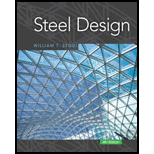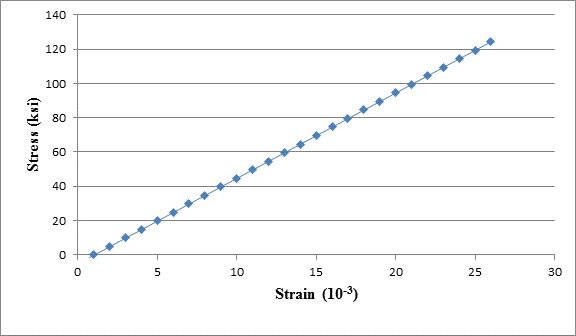
The data in Table 1.5.3 were obtained from a tensile test of a metal specimen with a rectangular cross section of
a. Generate a table of stress and strain values.
b. Plot these values and draw a best-fit line to obtain a stress-strain curve.
c. Determine the modulus of elasticity from the slope of the linear portion of the curve.
d. Estimate the value of the proportional limit.
e. Use the


Trending nowThis is a popular solution!

Chapter 1 Solutions
Bundle: Steel Design, Loose-leaf Version, 6th + Mindtap Engineering, 1 Term (6 Months) Printed Access Card
Additional Engineering Textbook Solutions
Structural Analysis (10th Edition)
Elementary Surveying: An Introduction To Geomatics (15th Edition)
Foundation Design: Principles and Practices (3rd Edition)
Elementary Surveying (14th Edition)
Structural Steel Design (6th Edition)
Materials for Civil and Construction Engineers (4th Edition)
- The tensile test was conducted on a specimen with a diameter of 0.5 inch. A strain gage was bonded to the specimen so that the strain could be obtained directly. The following data were obtained. a) create a table of stress and strain values. Plot this data points and draw the best fit straight line through them. b) what is the slope of this line? What does this value represent?arrow_forwardThe data shown in the table were obtained from a tensile test of a metal specimen with a rectangular cross-section of 0.2 in.? in area and a gage length (the length over which the elongation is measured) of 2.000 inches. a. Generate a table of stress and strain values. b. Plot these values and draw a best-fit line to obtain a stress-strain curve. c. Determine the modulus of elasticity from the slope of the linear portion of the curve. d. Estimate the value of the proportional limit. e. Use the 0.2% offset method to determine the yield stress.arrow_forward1.5-7 The data shown in the table were obtained from a tensile test of a metal specimen with a rectangular cross section of 0.2 in.² in area and a gage length (the length over which the elongation is measured) of 2.000 inches. d. Estimate the value of the proportional limit. e. Use the 0.2% offset method to determine the yield stress. Load (kips) 0 0.5 1.0 1.5 2.0 2.5 3.0 3.5 4.0 4.5 5.0 ܩܙ ܘ 5.5 6.0 6.5 Elongation × 10³ (in.) 0 0.160 0.352 0.706 1.012 1.434 1.712 1.986 2.286 2.612 2.938 3.274 3.632 3.976 Load (kips) 7.0 7.5 8.0 8.5 9.0 9.5 10.0 10.5 11.0 11.5 12.0 12.5 13 Elongation × 10³ (in.) 4.386 4.640 4.988 5.432 5.862 6.362 7.304 8.072 9.044 11.310 14.120 20.044 29.106arrow_forward
- The (G-E) diagram obtained in the tensile test performed on a metal sample with a diameter of 16 mm is as follows. The loads at points A, B and C and the elongation measured on l. 16 cm gauge length were determined as follows: B A B C Load (kgf) 4800 8400 7200 Elongation (mm) 0.192 28.8 38.4 c) Calculate the fracture work and the maximum elastic energy the metal rod can store. d) Find the cross-sectional area of a 6 m long rod made of this metal such that it can carry 12 tons of load with 2 times the safety of yield strength. How long does the rod extend under this load?arrow_forwardAn aluminium specimen with an initial gauge diameter d, = 10 mm and gauge length, 1, = 100 mm is %3D subjected to tension test. A tensile force P= 50 kN is applied at the ends of the specimen as shown, resulting in an elongation of 1 mm in gauge length. The Poisson's ratio (µ) of the specimen is Take shear modulus of material, G = 25 GPa. Consider engineering stress-strain conditions. Parrow_forwardIn a standard tensile test, an aluminum rod of 20-mm diameter is subjected to a tension force of P = 30 kN. Knowing that E = 70 GPa, and the change in diameter of the rod= 0.00955 mm, determine the poissons' ratio v. -20-mm diameter gage length=150 mmarrow_forward
- 1.16 The stress-strain relationship shown in Figure P1.16 was obtained during the tensile test of an aluminum alloy specimen. 60,000 H Stress, psi 40,000 20,000 0 Figure P1.16 0.002 0.004 0.006 0.008 Strain, in./in. Determine the following: a. Young's modulus within the linear portion. b. Tangent modulus at a stress of 45,000 psi c. Yield stress using an offset of 0.002 strain d. If the yield stress in part c is considered failure stress, what is the maximum working stress to be applied to this material if a factor of safety of 1.5 is used? 4arrow_forwardThe results of a tensile test are shown in Table 1.5.2. The test was performed on a metal specimen with a circular cross section. The diameter was 3⁄8 inch and the gage length (the length over which the elongation is measured) was 2 inches. a. Use the data in Table 1.5.2 to produce a table of stress and strain values. b. Plot the stress–strain data and draw a best-fit curve. c. Compute the modulus of elasticity from the initial slope of the curve. d. Estimate the yield stressarrow_forward2. A steel bar, whose cross section is 0.55 inch by 4.05 inches, was tested in tension. An axial load of P = 30,500 lb. produced a deformation of 0.105 inch over a gauge length of 2.05 inches and a decrease of 0.0075 inch in the 0.55-inch thickness of the bar. * Determine the lateral strain. Your answer Determine the axial strain. Your answer Determine the Poisson's rati v. Your answer Determine the decrease in the 4.05-in. cross-sectional dimension (in inches). * Your answerarrow_forward
- 2.31 A uniaxial test was performed on a bone specimen having a central (gauge) region initially 6 mm long and 2 mm in diameter. Five data points were recorded: Axial force (N) 94 190 284 376 440 Change in length (mm) 0.009 0.018 0.027 0.050 0.094 Plot the associated stress-strain relation, calculate a Young's modulus, and show that the yield stress is ~118 MPa. Recall that the yield stress reveals the transition from elastic to plastic (cf. Fig. 2.25). Data from Özkaya and Nordin (1999).arrow_forwardThe specimen shown is made from a 25 mm diameter cylindrical steel rod with two 38 mm outer-diameter sleeves bonded to the rod as shown. Knowing that E = 200 GPa, determine (a) the load P so that the total deformation is 0.05 mm, (b) the corresponding deformation of the central portion BC. 38 mm diameter P' 25 mm diameter B 38 mm diameter C 50 mm 75 mm 50 mmarrow_forwardSketch the stress-strain curve of the following tension test??? In the tension test of a metal fracture occurs at maximum load. The conditions at fracture were: A = 100 mm and L, = 60 mm, the initial values were: A = 150 mm and L. 40 mm.arrow_forward
 Steel Design (Activate Learning with these NEW ti...Civil EngineeringISBN:9781337094740Author:Segui, William T.Publisher:Cengage Learning
Steel Design (Activate Learning with these NEW ti...Civil EngineeringISBN:9781337094740Author:Segui, William T.Publisher:Cengage Learning Materials Science And Engineering PropertiesCivil EngineeringISBN:9781111988609Author:Charles GilmorePublisher:Cengage Learning
Materials Science And Engineering PropertiesCivil EngineeringISBN:9781111988609Author:Charles GilmorePublisher:Cengage Learning

